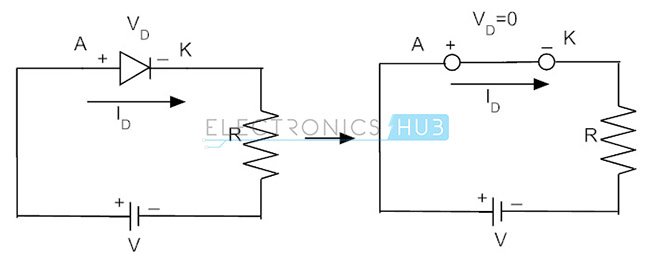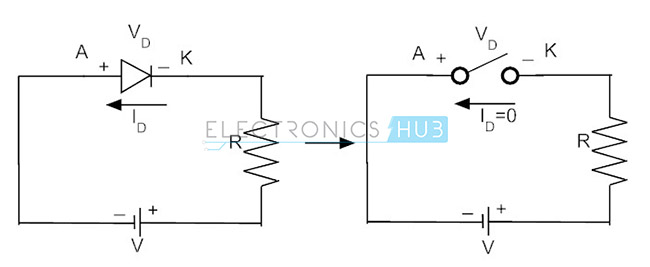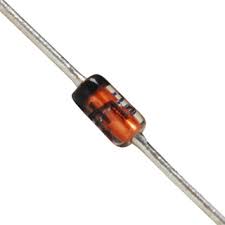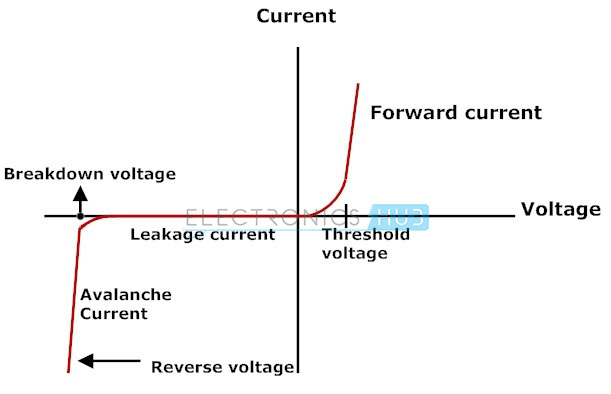In this tutorial, we will learn about a special diode called the Signal Diode. It is used in wave shaping, clamping, protection circuit and the main application of a Signal Diode is a Flyback Diode or Freewheeling Diode. We will see about 1N4148, a very commonly used Silicon Switching Signal Diode, its V-I Characteristics and few important specifications.
Outline
ToggleIntroduction
Diodes are often used as straightforward rectifiers, as mixers in compounding the signals and as switches to open or close a circuit. Diodes in the mixers are utilized for detecting the signals and these diodes are typically referred as signal diodes. The simple and conventional application of signal diodes is that it acts as a basic diode switch.
A signal diode could be a non linear semiconductor device available in recent days that form a kind of small elements of electrical and electronic circuits, made from the semiconductor crystals.
Signal diodes are widely acknowledged because they are frequently found in electronic circuits such as in televisions, radios, some other digital logic circuits and they are designed to drive very little or no power although high frequency currents exclusively in one direction.
The PN junction signal diode is usually fabricated in glass case or plastic case and generally has a black or a red band at the cathode end of the terminal.
Signal diodes have an advantage of quick recovery time and it has a huge variety of applications in signal processing. Signal diodes can be used for clocking functions in digital devices, conjointly serves to prevent the reverse signal from damaging of the microcontroller. Signal diodes will be employed in switching and clipping applications wherever short duration pulse waveforms are typically clipped off.
Signal diodes enable the current capability up to 100 milliamps and they are known for processing the information found in electrical signals sent from electrical transmitter. Germanium diodes have a forward voltage drop about 0.2 volts are used as detecting circuits in radios.
In electronic circuits that do not require the accuracy of germanium diodes, silicon semiconductor, signal diodes are normally employed owing to their lower value of resistance and their vulnerability to heat.
Types of Signal Diodes
Here is the list of some of the signal diodes which are frequently used.
- 1N4973
- 1N4148
- 1N34A (Germanium Diode)
- 1N4454
Small signal diodes have low power and current ratings, around 500mW & 150mA almost compared to traditional rectifier diodes. The characteristics of a signal diode are completely different for germanium signal and silicon signal diodes. They are given as follows:
[adsense2]
Germanium Signal Diodes – These diodes have very little amount of reverse bias resistance values resulting in a low forward voltage drop across the PN junction, usually about 0.2 V- 0.3 V, however it has a high forward bias resistance value attributable to the small PN junction area.
Silicon Signal Diodes – These diodes have a terribly high reverse bias resistance values leading to a forward voltage drop about 0.6 – 0.7V across the PN junction. They have moderately low values of forward bias resistance resulting in higher values of forward current and reverse bias voltage.
V-I Characteristics of a Signal Diode
If both the positive and negative terminals of external power supply are connected to the respective terminals of the PN junction, then the signal diode is said to be in Forward Bias. The voltage supplied to the diode in forward bias generates a forward current denoted by IF.
The value of forward current is directly proportional to the external voltage applied and reciprocally proportional to the inbuilt resistance of the diode. The electrostatic force that prohibits the electrons and holes passing away from the junction due to the effect of charge ions within the depletion layer is named as barrier voltage
The typical values of barrier voltage at the p-n junction of germanium diode are 0.2 V ~ 0.3 V, whereas it is 0.6 V~ 0.7 V for silicon diode.
If the positive terminal of the supply is connected to cathode of the signal diode and negative terminal is connected to anode of the diode, then the signal diode is said to be in reverse bias. When an external voltage is applied to the diode in reverse bias, a small amount of current known as leakage current exists due to the minority charge carriers crossing the depletion layer and moving away from it.
This leakage current is also termed as Reverse Saturation Current denoted by or which is independent of external voltage applied, but depends on the temperature of the device.
If the applied reverse bias voltage is very high, the minority charge carriers acquire enough energy to collide and split up the covalent bonds to generate a significant number of electron – hole pairs.
The phenomenon of electron – hole pair generation is called as breakdown. The maximum reverse voltage applied to the diode before its breakdown condition can be referred as peak reverse voltage or peak inverse voltage.


In forward bias, signal diode acts as closed switch and thus short circuited for driving current solely in one direction (from the positive terminal to the negative terminal). In reverse bias, silicon diode acts as open switch and thus open circuited for blocking the current flowing in the diode.
Silicon signal diodes act as rectifiers, switching circuits, limiting circuits and in clipping circuits for clipping the short duration waveforms.
Signal Diode Characteristics
The parameter details of the signal diode characteristics and specifications for signal diodes are given below.
Peak Inverse Voltage (PIV)
Peak Inverse Voltage parameter is defined as the maximum amount of voltage that can be applied to the diode in reverse direction. This peak voltage should not be exceeded because the voltage greater than this peak voltage may cause the device failure. It is also referred to as maximum reverse voltage and it is less than the avalanche breakdown condition of the diode in reverse bias characteristic.
Typical values of peak inverse voltage may vary from a few volts to thousands of volts. In rectifier circuits with regards to amplitude, the peak inverse voltage is termed as the utmost negative value of the sine-wave surrounded by a cycle’s negative alternation.
Power Dissipation (PD)
Total power dissipation is defined as the maximum amount of power that will be dissipated at the PN junction signal diode during the conduction of current. The excess power will be dissipated in the form of heat. The forward resistance of signal diode is a dynamic property, it is very small and sometimes it is varied.
In that condition the total power dissipated will be measured by multiplying the voltage applied to the diode and forward current flowing through the signal diode.
Forward Current (IF)
The forward current rating parameter of a signal diode is defined as the maximum amount of anode current that a signal diode can handle easily without damaging the device. If the current exceeds the forward current rating value, then the signal diode may get damaged at the junction due to thermal overload.
Operating Temperature (T)
The maximum operating temperature parameter of a signal diode is more often related to the total power dissipation and also related to the temperature of the PN junction. It is defined as the maximum temperature of the device at which maximum forward current is reached.
Beyond this temperature value the device gets damaged and leads to failure of the device. The PN junction signal diode should be maintained at a temperature wherein the maximum forward current is achieved before it gets deteriorates.
Specifications of 1N4148 Signal Diode
Here are some specifications of 1N4148 signal diode. They are as follows.
- Maximum repetitive reverse voltage = 100 V
- Average rectified forward current = 200 mA
- Maximum direct forward current = 300 mA
- Maximum forward voltage drop = 1.0 V at 10 mA.
- Non-repetitive peak forward surge current = 1.0 A (pulse width = 1 s)
- Total power dissipation = 500 mW
- Reverse recovery time < 4 ns



